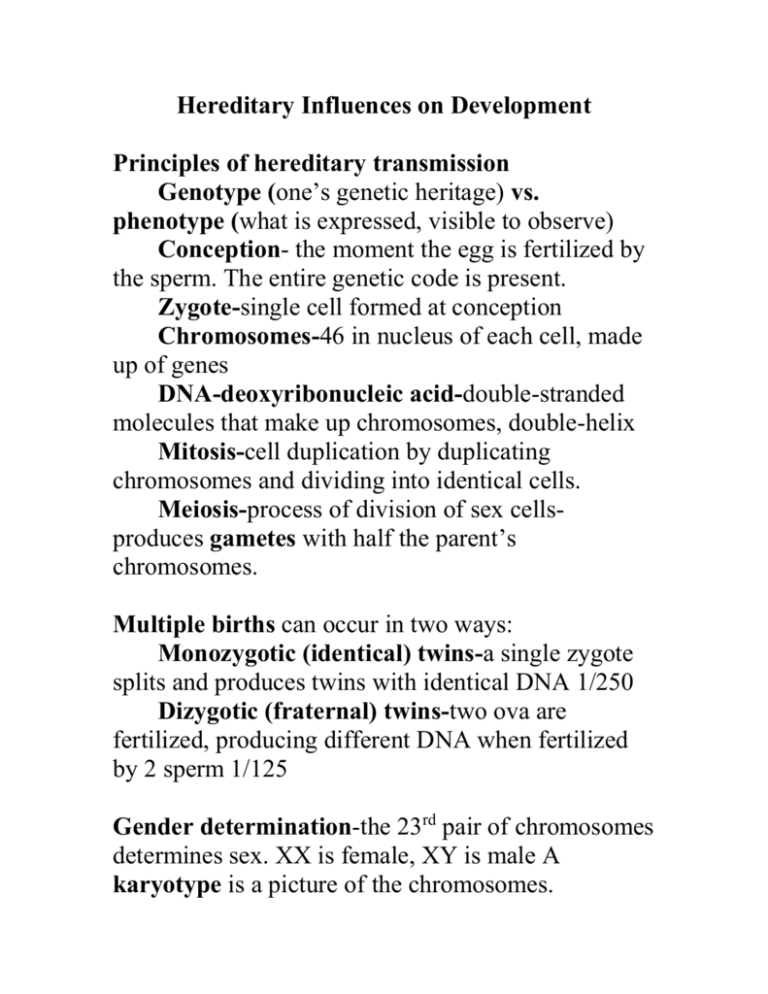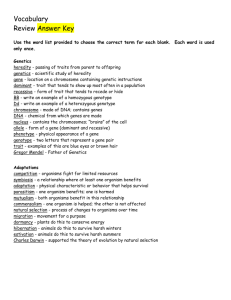STRESS, HEALTH, & COPING
advertisement

Hereditary Influences on Development Principles of hereditary transmission Genotype (one’s genetic heritage) vs. phenotype (what is expressed, visible to observe) Conception- the moment the egg is fertilized by the sperm. The entire genetic code is present. Zygote-single cell formed at conception Chromosomes-46 in nucleus of each cell, made up of genes DNA-deoxyribonucleic acid-double-stranded molecules that make up chromosomes, double-helix Mitosis-cell duplication by duplicating chromosomes and dividing into identical cells. Meiosis-process of division of sex cellsproduces gametes with half the parent’s chromosomes. Multiple births can occur in two ways: Monozygotic (identical) twins-a single zygote splits and produces twins with identical DNA 1/250 Dizygotic (fraternal) twins-two ova are fertilized, producing different DNA when fertilized by 2 sperm 1/125 Gender determination-the 23rd pair of chromosomes determines sex. XX is female, XY is male A karyotype is a picture of the chromosomes. Functions of the genes Produce amino acids necessary for the formation & function of new cells Regulate the pace of development Even so, environmental factors influence how messages from the genes are carried out Dominant-recessive inheritance is produced by alleles (different forms of a gene that can appear on a chromosome) and the combination of alleles. Simple inheritance requires only one genetic pair. Dominant allele-more powerful gene that is expressed in the phenotype Recessive allele-less powerful gene that us not expressed unless paired with another recessive allele. Carrier-person who displays no sign of a recessive trait in his phenotype, but carries the recessive allele and can pass the trait on to child. Codominant-2 equally powerful alleles can compete for dominance and both be expressed. (AB blood type has allele for both A and B, with equal portions of A- and B-antigens. Sickle cell anemia can be carried recessively, but it affects blood cells to some extent, not producing severe signs of disease. Sex-linked characteristic-traits that are determined by genes on the sex chromosomes, mostly on the X, so they affect males more intensely (since they only have one X) Color-blindness 8/100M Genetic imprinting-a pattern of inheritance in which only one parent’s gene is expressed, regardless of whether it is dominant or recessive. Polygenic traits -one trait that is created by the action of several genes, not simply one. Height, weight, IQ, skin color, temperament, risk of cancer. Abnormalities Congenital defects- defects present at birth even if they aren’t noticeable. (Huntingdon’s disease is present at birth but doesn’t begin the CNS deterioration until later in life.) Chromosomal Abnormalities-if during the meiotic reproduction of alleles the distribution of chromosomes is uneven, it’s usually fatal and results in abortion of the fetus. Some simply produce odd characteristics: Turner’s syndrome XO, Superfemale XXX, Kinefelter’s syndrome XXY, Supermale XYY Fragile-X syndrome-one X has broken off, causes mental retardation, infantile autism, sterility Down syndrome-is caused by trisomy 21, where the 21st chromosome has extra chromosomal material or not enough. Facial features are common, mild to serious mental retardation, heart and sensor (ear, eye) defects. Aging-ova hypothesis-one hypothesis for chromosomal abnormalities- aging mothers have aging eggs with deteriorate. Also some mothers don’t metabolize folic acid well and puts baby at risk. Genetic Abnormalities-can result as a result of mutations- spontaneous changes in the structure of a gene that produces a new phenotype. Recessive hereditary defects occur when both parents carry a recessive gene for a disease and the child inherits both. Sickle cell anemia. CF, PKU, hemophilia, Tay-Sachs disease. Genetic Counseling serves to help parents know the risk of delivering a child with abnormalities due to inheritance. It is particularly encouraged if the couple has already delivered a child with abnormalities. Prenatal Detection of abnormalities Amniocentesis- extracting amniotic fluid with fetal cells that can be tested for abnormalities. May be done after 11-14 wks gestation. Chorionic villus sampling (CVS)- take fetal cells from the chorion for testing. Can be done 8-9 weeks gestation. Has a greater risk of miscarriage. Ultrasound-scanning the womb externally with sound waves to produce a visual of fetus. Helpful for detecting gross abnormalities, multiple babies. Treating hereditary disorders-with many severe disorders, there is no treatment, but the parents have the option of abortion. PKU- phenylketonuria-disease where baby can’t metabolize phenylanaine, a protein which builds up in toxicity and produces mental retardation. All babies are tested at birth. Those with it must stay on a special diet, in which no toxins are produced. Intrautero fetal surgery-can repair some heart, neural tube, urinary tract or lungs can be corrected. Gene replacement therapy-CF-cystic fibrosisthe CF gene has been pinpointed and can be neutralized. Gene replacement therapy inserts normal genes to replace the defective gene. Germline gene therapy-potential therapy where harmful genes are altered or replaced with healthy ones in the embryonic stage. Still not OKed for humans. Ethical issues – Fetal surgery can induce miscarriage & problems from complications. Gene replacement therapy-benefits outweigh the risks for children with severe illnesses. Germline gene therapy this could alter genotypes for future generations (positive eugenics) which brings the question- Who decides what is a positive enhancement of the human race? Do we start rejecting more and more borderline functioning people because they are inconvenient? Even today in vitro fertilization techniques allow parents to choose the gender of their babies. Sonograms in China have changed the rates of boys/girls there. The results of negative eugenics were seen in Nazi Germany as they attempted to eliminate all the “undesirables”. In this country we have allowed legal sterilization of mentally retarded adults with little legal rights under the law. Methods of study of hereditary influences Behavioral genetics- study of how genotype interacts with environment to produce personal attributes such as IQ, personality, disorders. Heritability studies seek to determine the heritability of various traits. How much a trait is determined by heredity or environment. Selective breeding studies track breeding of animals to try to develop certain traits. Family kinship studies-examining traits according to how genetically similar members are who carry it. Twin design-comparing twins reared together to fraternal twins on a specific trait. Adoption design-compares adoptees to genetically unrelated people in the family. Concordance rates-comparing percentages of one twin with a trait to the other twin. (If a trait is found in both twins all the time, it is 100% concordant. If it is present half the time, it is 50%) Heritability coefficient-the estimate of variation in a attribute that is attributable to heredity. IQ is .52 heritable (meaning over half the trait can be linked to genetics) Nonshared environmental influencesenvironment that people living together don’t share that contributes to differences in family members. Activities, friends, treatment by parents. Parents, especially dads treat boys differently from girls. It contributes a lot to personality differences. Siblings treat one another differently depending on birth order. Shared environmental influences-experiences the family members share that contribute to similarity Misconceptions about heritability-estimates only apply to populations, not individuals. They differ with different environmental influences. They are subject to modification by environment. Inheritance is not unchangeable. Hereditary influences on IQ-Genetic influences appear more obviously the older the child grows. The influence of shared environment declines with age. Hereditary influences on personality-while overall the hereditary influence on personality is more subtle than in IQ, some traits are highly heritable. Introversion/extroversion-similar level of heritability as IQ, since this has to do with physiological responses to novel stimuli. Empathy-measure of how much a person recognizes and responds to the needs of others. This is noticeable soon after birth in nursery – how much some children respond to others’ crying. Hereditary influences on Mental disordersSchizophrenia-genetic connection from parent shown in concordance rates of identical twins compared to fraternal twins (.48 Id, .17 frat) Manic-depression-mood disorders show high levels of heritability Neurotic disorders-brain response is heightened, more stimuli are considered threats. There is a predisposition to develop illness, not a mandate. Environment does figure in here. Canalization principle-restriction of phenotype to only a few outcomes- the more canalized a trait is, the more predetermined the outcome, so environment has less possible effect. Babbling in infancy is common to all babies, even deaf ones. Range-of-Reaction Principle- genotype restricts the range of possible manifestations- variety is possible. Passive genotype/environment correlationsrearing environments of a child are influenced by the parents’ genes. More empathic or athletic parents will set up opportunities to display and reward those behaviors in child, triggering their inheritance. Evocative genotype/environment correlationsour genetic dispositions affect the people who raise us and influence our social environment. Temperament really figures in here. Active genotype/environment correlations-our genetic predispositions will lead us to seek environments that fit us, enhancing those traits. Goodness of fit makes a difference here – the better the child’s traits match the parents, the better parenting they receive, the more affirmed and confident they will become. Separated identical twins-Bouchard studied 100 pairs of twins separated at birth and reunited as adults. He found remarkable similarities in traits, regardless of environment raised in. Even so they had differences, somewhat due to the differences in environment. “Good Enough” parenting?- Scarr believes people have such a strong genetic drive to become who we are supposed to be, that reasonable parenting is sufficient. Genes will out within a broad range of environments. Only severe abuse or neglect will restrict the natural development of a person. This is seen cross-culturally with a wide variety of parenting practices still producing functional adults. Good enough parenting presupposes normal behavioral practices. Because children also get responses from many other people beyond the parents, parents can’t completely mold a child. Baumrind disagreed, studying parenting styles and finding consistent differences in how children turn out, depending on how supportive and guiding the parents are. Parents need to feel invested in the process to offer children the best opportunities to fulfill potential. The society needs to feel invested to continue pouring in resources into interventions that have positive results, such as in school success, moderating violence, etc. Hereditary Influences on Development Principles of hereditary transmission Genotype vs. phenotype Conception Zygote Chromosomes DNA-deoxyribonucleic acid Mitosis Meiosis Multiple births Monozygotic (identical) twins Dizygotic (fraternal) twins Gender determination Functions of the genes Dominant-recessive inheritance Dominant allele Recessive allele Carrier Codominant Sex-linked characteristic Genetic imprinting Polygenic traits Abnormalities Congenital defects Chromosomal Abnormalities Fragile-X syndrome Down syndrome Aging-ova hypothesis Genetic Abnormalities Recessive hereditary defects Mutations Genetic Counseling Prenatal Detection of abnormalities Amniocentesis Chorionic villus sampling (CVS) Ultrasound Treating hereditary disorders PKU- phenylketonuria Intrautero fetal surgery Gene replacement therapy-CF-cystic fibrosis Germline gene therapy Ethical issues Methods of study of hereditary influences Behavioral genetics Heritability studies Selective breeding studies Family kinship studies Twin design Adoption design Concordance rates Heritability coefficient Nonshared environmental influences Shared environmental influences Misconceptions about heritability Hereditary influences on IQ Hereditary influences on personality Introversion/extroversion Empathy Hereditary influences on Mental disorders Schizophrenia Manic-depression Neurotic disorders Canalization principle Range-of-Reaction Principle Passive genotype/environment correlations Evocative genotype/environment correlations Active genotype/environment correlations Separated identical twins “Good Enough” parenting?








